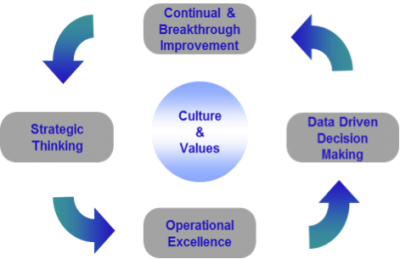Fundamentally Lean Six Sigma is a system to address strategic gaps, by improving the efficiency and effectiveness of existing processes, and developing new products, processes and services, using defined methodologies and tools. Lean Sigma's impressive results in organisations such as Motorola, GE and Toyota are often quoted as evidence of the benefits that can be achieved by applying the methods and tools to business problems.
However, this is not the end of the story. If we examine the Motorola story, the GE story, the Toyota story or many others that have achieved success using Lean and Six Sigma methods it becomes clear that the methods and tools alone are not the reason for the success of these initiatives. In each case there has been a strong leader, who had an unshakeable belief in the direction the organisation needed to go, and the need for excellence, continuous and never ending improvement has been embedded in the culture of the organisation.

At SigmaPro we have studied many organisations that have achieved success, and identified four organisational competences that are required to achieve a sustainable approach to business improvement. These are Strategic Thinking, Operational Excellence, Data Driven Decision Making and Continual & Breakthrough Improvement. Supported by the right kind of culture, value and leadership, an organisation can achieve sustainable improvement. If any of these components are missing, the organisations approach to improvement will not be sustained. Sustainability requires a holistic approach to organisation improvement, it is not just about methods and tools.
The other part of our research has established that organisations don’t change overnight to suddenly become a six Sigma or lean company. Most will progress through stages of maturity, developing their approaches to organisation improvement as they go. Even looking back to Motorola and Toyota it is clear that their improvement approaches were developed over years, even decades. Learning from them means that today’s organisations can progress much quicker, but each organisation is different and needs to develop its own approaches to fit its own culture and that of its environment as it changes.
The Sigma research has highlighted three phases that organisations go through on their improvement journey before they reach maturity, these being establishing sound foundations, building for future success and putting in place the final blocks required to ensure sustainability.

It’s a bit like building a house, first the foundations, then the walls, then finally the roof. Once these are in place and the building is watertight, you can continue to work on the inside, start inside before these things are done and you’re wasting your time!
To embed a sustainable approach to organisation improvement, those responsible for such initiatives must understand the current status of the organisation in relation to the organisational competences, understand the level of maturity and understand organisation culture. If these 3 things are understood, then the real work of creating a sustainable approach to improvement can begin!